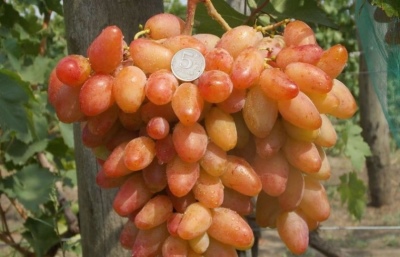
- Authors: Burdak Alexander Vasilievich
- Appointment: dining room
- Berry color: white-pink
- Taste: harmonious
- Ripening period: average
- Ripening period, days: 125-135
- Frost resistance, ° C: -22
- Bunch weight, g: 600–1000
- Flower type: bisexual
- Peeling: negligible
Beautiful large and crunchy ripe fruits of the most delicate amber or pinkish hue, hanging on huge clusters, belong to the tasty and juicy Dixon grapes.
Breeding history
This variety, like most modern ones, is a hybrid. The grapes were bred by the breeder Burdak Alexander Vasilyevich during the crossing of two interspecific varieties Atlant Zaporozhsky and Angelica. Dixon belongs to the group of table or dessert varieties, which means that the fruits of the plant can be eaten. The fruits of the grapes can also be used to create compotes, preserves, marinades.
The hybrid origin of the plant also allows it to be transportable, it can withstand transportation while maintaining its taste.
Description
Dixon is a vigorous, tall, sturdy shrub with bisexual flowers that require cross-pollination. The plant is great both for creating summer cottages or hedges, and for forming a mini-plantation. Easily rooted and propagated through cuttings.
Ripening period
Dixon belongs to the early-medium or mid-season varieties. The rich amber-colored fruits ripen by the end of summer, beginning of autumn (August-September).
Bunches
The bunches are branched, collected in loose bundles of a cylindrical-conical, elongated shape. On average, the weight of each bunch fluctuates around 600-1000 grams. With a well-formed bush, Dixon's clusters increase in size and weight. Peas in fruits is insignificant.
Berries
The berry is large, two-colored, gradient (most often the color is from red, red-orange to green-yellow, pinkish-white color is also allowed), firm.
The shape is elongated-oval or elongated-cylindrical, in the middle the fruit has a slight thickening. Sometimes the berries take on a fusiform shape with a pointed end. The weight of one fruit is 14-18 grams, in large specimens it can reach 20 g, the length of the grape is on average about 6 cm.
Taste
The skin of the berry is medium in thickness; when eaten, a crunch is observed, due to the increased juiciness and sugar content of the fruit (220-230 g / dm3). The taste of the grapes is tart, sweet, quite harmonious.
Yield
Dixon is a high-yielding variety. The fruitfulness of the plant is high, the grape vines ripen easily.


Growing features
Since the bush is vigorous, it is necessary to monitor its formation, prune in time, control the nutritional value of the soil and monitor its watering, since with an excess of moisture, ripe fruits crack, and there is a possibility of gray mold disease.
Landing
Planting grapes is carried out in well-lit areas.The Dixon variety is easily grown in the southern regions and to the north, the main condition is that in the spring-summer period the sum of active temperatures should not be lower than 2500 ° С. The distance between the bushes should be kept within at least 1.5 meters. Planting holes must be covered with drainage material. The bushes are sprinkled with a nutritious loose substrate. Loosening of the topsoil is a prerequisite in the first years of a plant's life.

Pollination
The growing season for Dixon is average, equal to 125-135 days (from the dissolution of the flower bud to the ripening of the fruit). Flowers are pollinated by various insects, most often bees. If there is a problem with fruit setting on the site, then you can independently pollinate the buds with a soft brush.
Pruning
Cutting ripe bunches is carried out approximately at the end of August. After harvesting, it is necessary to form a bush for wintering and further fruiting. The fruit branch is shortened to the length at which 7 or 8 eyes are preserved, during the growth period (in spring) the vines are cut into 35-45 eyes. Such pruning not only allows the vines to ripen better, but also increases the subsequent fruiting of the bush.



Frost resistance and the need for shelter
The frost resistance of the plant is medium resistant. Dixon is able to withstand frosts down to -22 ° C, but the bush must be covered for the winter. Both regular mulch and wrapping in a film or other dense material are suitable.

Diseases and pests
With abundant watering and rainy weather, grape bushes can become covered with gray rot. This is a fungal disease, the causative agent is Botrytis cinerea. This ailment is treated by watering the soil with water with fungicidal agents dissolved in it and spraying the bushes. All diseased fruits and vines are removed and burned. In severe cases, the annual layer of the bark is removed.

If a grape is exposed to any disease or insect, this always affects its appearance.
Storage
The collected bunches are stored in a cold room in boxes lined with soft material or straw. The wax coating is not washed off from the berries, this natural film is necessary for the preservation of the fruit. From time to time, the bunches must be sorted out (removing spoiled fruits) and turned so that there is no stagnation.
The Dixon variety is unpretentious in care, frost-hardy and resistant to most diseases, having excellent taste, coupled with high yields.In just a couple of years, all this allowed him to gain recognition among farmers and amateur gardeners.











































































